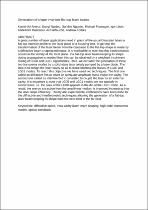JavaScript is disabled for your browser. Some features of this site may not work without it.
- ResearchSpace
- →
- Research Publications/Outputs
- →
- Conference Publications
- →
- View Item
| dc.contributor.author |
Ait-Ameur, K

|
|
| dc.contributor.author |
Naidoo, Darryl

|
|
| dc.contributor.author |
Ngcobo, Sandile

|
|
| dc.contributor.author |
Fromager, M

|
|
| dc.contributor.author |
Litvin, I

|
|
| dc.contributor.author |
Hasnaoui, A

|
|
| dc.contributor.author |
Harfouche, A

|
|
| dc.contributor.author |
Forbes, A

|
|
| dc.date.accessioned | 2016-04-22T07:27:23Z | |
| dc.date.available | 2016-04-22T07:27:23Z | |
| dc.date.issued | 2015-02 | |
| dc.identifier.citation | Ait-Ameur, K, Naidoo, S, Ngcobo, S, Fromager, M, Litvin, I, Hasnaoui, A, Harfouche, A, and Forbes, A. 2015. Generation of shape-invariant flat-top laser beams. In: 2015 Proceedings of SPIE 9434, Laser Resonators, Microresonators, and Beam Control XVII, San Francisco, California, United States, 7 February 2015. | en_US |
| dc.identifier.uri | http://proceedings.spiedigitallibrary.org/mobile/proceeding.aspx?articleid=2194908 | |
| dc.identifier.uri | http://hdl.handle.net/10204/8511 | |
| dc.description | 2015 Proceedings of SPIE 9434, Laser Resonators, Microresonators, and Beam Control XVII, San Francisco, California, United States, 7 February 2015. Due to copyright restrictions, the attached PDF file only contains the abstract of the full text item. | en_US |
| dc.description.abstract | A great number of laser applications need in place of the usual Gaussian beam a flat-top intensity profile in the focal plane of a focusing lens. In general the transformation of the laser beam from the Gaussian to the flat-top shape is made by a diffractive beam shaping technique. It is worthwhile to note that this transformation occurs in the vicinity of the focal plane. If a flat top laser beam keeping its shape during propagation is needed then this can be obtained by a weighted incoherent mixing of LG(sub0)0 and LG(sub01) eigenmodes. Here, we consider the generation of these two transverse modes by a solid-state laser axially pumped by a laser diode. The idea is to design the laser cavity so as to make identical the losses of LG(sub00) and LG(sub01) modes. To reach this objective we have used two techniques. The first one called as diffractive lies to insert an adequate amplitude mask inside the cavity. The second one called as interferometric consisted to couple the laser to an external cavity. It is important to note that LG(sub00) and LG(sub01) modes are not spatially in concurrence, i.e. the peak of the LG(sub00) appears in the dip of the LG(sub01) mode. As a result, the energy extraction from the amplifying medium is improved increasing thus the laser slope efficiency. Theory and experimental verifications have been done for the diffractive and interferometric techniques allowing the generation of a flat-top laser beam keeping its shape from the near-field to the far-field. | en_US |
| dc.language.iso | en | en_US |
| dc.publisher | SPIE | en_US |
| dc.relation.ispartofseries | Worklist;14888 | |
| dc.subject | Diffractive optics | en_US |
| dc.subject | Intra-cavity laser beam shaping | en_US |
| dc.subject | High order transverse modes | en_US |
| dc.subject | Optical feedback | en_US |
| dc.title | Generation of shape-invariant flat-top laser beams | en_US |
| dc.type | Conference Presentation | en_US |
| dc.identifier.apacitation | Ait-Ameur, K., Naidoo, D., Ngcobo, S., Fromager, M., Litvin, I., Hasnaoui, A., ... Forbes, A. (2015). Generation of shape-invariant flat-top laser beams. SPIE. http://hdl.handle.net/10204/8511 | en_ZA |
| dc.identifier.chicagocitation | Ait-Ameur, K, Darryl Naidoo, Sandile Ngcobo, M Fromager, I Litvin, A Hasnaoui, A Harfouche, and A Forbes. "Generation of shape-invariant flat-top laser beams." (2015): http://hdl.handle.net/10204/8511 | en_ZA |
| dc.identifier.vancouvercitation | Ait-Ameur K, Naidoo D, Ngcobo S, Fromager M, Litvin I, Hasnaoui A, et al, Generation of shape-invariant flat-top laser beams; SPIE; 2015. http://hdl.handle.net/10204/8511 . | en_ZA |
| dc.identifier.ris | TY - Conference Presentation AU - Ait-Ameur, K AU - Naidoo, Darryl AU - Ngcobo, Sandile AU - Fromager, M AU - Litvin, I AU - Hasnaoui, A AU - Harfouche, A AU - Forbes, A AB - A great number of laser applications need in place of the usual Gaussian beam a flat-top intensity profile in the focal plane of a focusing lens. In general the transformation of the laser beam from the Gaussian to the flat-top shape is made by a diffractive beam shaping technique. It is worthwhile to note that this transformation occurs in the vicinity of the focal plane. If a flat top laser beam keeping its shape during propagation is needed then this can be obtained by a weighted incoherent mixing of LG(sub0)0 and LG(sub01) eigenmodes. Here, we consider the generation of these two transverse modes by a solid-state laser axially pumped by a laser diode. The idea is to design the laser cavity so as to make identical the losses of LG(sub00) and LG(sub01) modes. To reach this objective we have used two techniques. The first one called as diffractive lies to insert an adequate amplitude mask inside the cavity. The second one called as interferometric consisted to couple the laser to an external cavity. It is important to note that LG(sub00) and LG(sub01) modes are not spatially in concurrence, i.e. the peak of the LG(sub00) appears in the dip of the LG(sub01) mode. As a result, the energy extraction from the amplifying medium is improved increasing thus the laser slope efficiency. Theory and experimental verifications have been done for the diffractive and interferometric techniques allowing the generation of a flat-top laser beam keeping its shape from the near-field to the far-field. DA - 2015-02 DB - ResearchSpace DP - CSIR KW - Diffractive optics KW - Intra-cavity laser beam shaping KW - High order transverse modes KW - Optical feedback LK - https://researchspace.csir.co.za PY - 2015 T1 - Generation of shape-invariant flat-top laser beams TI - Generation of shape-invariant flat-top laser beams UR - http://hdl.handle.net/10204/8511 ER - | en_ZA |






